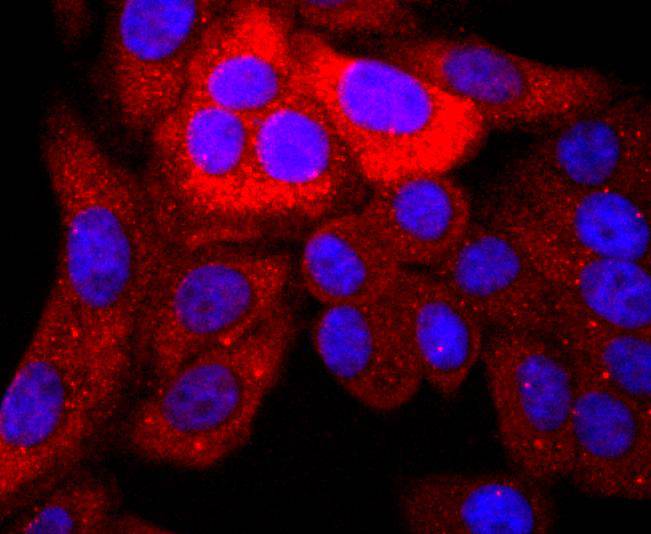Product Detail
Product NameS100P Rabbit mAb
Clone No.JF95-08
Host SpeciesRecombinant Rabbit
Clonality Monoclonal
PurificationProA affinity purified
ApplicationsWB, ICC/IF, IHC, IP
Species ReactivityHu
Immunogen Descrecombinant protein
ConjugateUnconjugated
Other NamesMIG9 antibody Migration inducing gene 9 antibody Protein S100-E antibody Protein S100-P antibody Protein S100P antibody S100 calcium binding protein P antibody S100 calcium-binding protein P antibody S100 P antibody S100E antibody S100P antibody S100P_HUMAN antibody
Accession NoSwiss-Prot#:P25815
Uniprot
P25815
Gene ID
6286;
Calculated MW10 kDa
Formulation1*TBS (pH7.4), 1%BSA, 40%Glycerol. Preservative: 0.05% Sodium Azide.
StorageStore at -20˚C
Application Details
WB: 1:500-1:1000
IHC: 1:50-1:200
ICC: 1:50-1:200
IP: 1:50-1:100
Immunohistochemical analysis of paraffin-embedded human colon cancer tissue using anti-S100P antibody. Counter stained with hematoxylin.
ICC staining S100P in HepG2 cells (red). The nuclear counter stain is DAPI (blue). Cells were fixed in paraformaldehyde, permeabilised with 0.25% Triton X100/PBS.
ICC staining S100P in Hela cells (red). The nuclear counter stain is DAPI (blue). Cells were fixed in paraformaldehyde, permeabilised with 0.25% Triton X100/PBS.
S-100 proteins are small dimeric members of the EF-Hand superfamily that participate in moderating intracellular calcium signals by binding to and regulating specific proteins in a calcium-dependent manner. S-100P is a survival factor that is associated with different types of tumors and can bind and regulate effector proteins. R1881, a synthetic androgen, regulates S-100P expression. S-100P interacts with a receptor for advanced glycation end products (RAGE) and activates it, thereby increasing the rates of cell growth, division, migration and invasion. This suggests that S-100P acts in an auto-crine manner through RAGE to trigger cell proliferation and survival. S-100P may also positively affect anchorage-independent growth to improve tumor formation. S-100P monomers strongly interact with one another, but not with other S-100 polypeptides, suggesting that homodimer formation is necessary for S-100P to function. The S-100P dimers are then stabilized by hydrophobic contacts.
If you have published an article using product 49396, please notify us so that we can cite your literature.





 Yes
Yes



